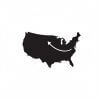



Queen Elizabeth II 25th Anniversary Coronation First Day Cover, St. Helena postmarked on June 2, 1978.
St. Helena
1200 miles west of Africa and 700 miles southeast of Ascension, St. Helena rises rugged and mountainous, culminating in , the 2685 ft. Mount Actaeon. Its European, Asian and African population of 5000 came from its use as a staging post on the Britain to Australia and Far East voyages, and as a depot for liberated slaves, St. Helena being a British base in the early 19th century for the suppression of the slave trade.
The local heraldic beast shown in this Omnibus issue is the Sea Lion, a device used many years ago by the London East India Company. The sea lion proper (on which the heraldic beast is based) is, in fact, to be found in St. Helena, as well as on other coasts in South and North America, South Africa, Australia and New Zealand. It grows to between five and twelve feet, with reddish-brown to black coarse hair, and unlike its relative the fur seal, has no distinct underfur. The sealion is gregarious, gathering in colonies to mate, each dominant male having a harem of about fifteen females. It feeds on fish, cephaloids, sea birds and crustaceans.
Also depicted in the issue is the Black Dragon of Ulster. The salt-water dragon Tiamat (so the Babylonian creation myth tells) — god of primeval chaos, was slain by Marduk and her body split in twain to form the oceans and the rainfilled heavens. Ancient Indo-European legend tells of Indra, often referred to as the bull, striking the dragon-clouds with his thunderbolt to make it rain; and the Ancient Egyptian God Nun was not only the primeval ocean, and the source of the Nile, but took the form of a serpent. Thus coming to have general meaning of divine guardianship, the symbol was used on the standards of Phoenicians, Assyrians, Persians, Scythians and Parthians, who gave it to the Romans. They fastened the emblem on spears, mouth agape so it would hiss in the wind.
The dragon-serpent turns up wherever the Indo-Europeans went; on Viking ship prows, as the name of Celtic Chieftains, on shields of invading Normans, and the Lionheart's crusaders. And not only the Indo-Europeans; when a Saracen Emir fell beneath the walls of Jerusalem to the Count of Milan, he was sporting the draconian divine protection on his shield! The count took it for his arms, and passed it on through his daughter's marriage to Lionel, Earl of Ulster . . . and he was the great great grandfather of Edward IV, first royal user of this Queen's Beast.
Shipping:
-
We ship via USPS, UPS or FedEx. At this time, we do not offer shipping to addresses with an APO/FPO or outside the continental United States.
Shipping Time:
Orders are normally shipped from our warehouse within 24 - 48 business hours of order placement. Please allow 7 - 10 business days for delivery after your order has shipped. Delivery times are estimated and we do not provide money-back guarantee for any shipping option other than FedEx Express or UPS Next Day.
Terms of Use and Security
-
We use cookies to store visitors preferences, record session information, such as items that consumers add to their shopping cart, record user-specific information on what pages users access or visit, alert visitors to new areas that we think might be of interest to them when they return to our site. If you do not want to receive e-mail from us in the future, please let us know by sending us an e-mail. If you supply us with your postal address on-line you may receive periodic mailings from us with information on new products, special pricing and services or upcoming events. If you do not wish to receive such mailings, let us know by sending us an e-mail. Please provide us with your exact name and address. Persons who supply us with their telephone numbers on-line will only receive telephone contact from us with information regarding orders they have placed on-line. With respect to security: We have appropriate security measures in place in our physical facilities to protect against the loss, misuse or alteration of information that we have collected from you at our site. If you feel that this site is not following its stated information policy, you may contact us at your discretion.
Returns & Replacements
-
We accept returns within 30 days of the date of purchase unless otherwise stated on the item's page. In order to return an item, please contact us for a Return Authorization Number. Once the Return Authorization Number is acquired, you have 30 days to return the item(s). All returned items must be unused and in new condition in their original packaging including all hardware and instructional components. Items are also subject to a 20% restocking fee. Although if you are a repeat customer who purchased from our website before, we are happy to waive the restocking fee.
Any returned item deemed not to fall within the preceding criteria will be returned with no credit issued at the customer's expense. Once your return has been inspected please allow 15 days for the credit to be applied to the credit card used for purchase. The initial cost of shipping is not eligible for a refund. Buyer pays for return shipping. To request your Return Authorization Number, please follow these steps:
-
1. Read and agree to the Returns Policy and Procedure above.
-
2. Email us at cs@phenomstores.com. We will need your order number and the Item ID number of the product you wish to return.
Refused Orders - Should you decide that you wish to refuse receipt of an item when delivered by UPS, USPS or any other common carrier and legitimately ordered from us, credit will be issued for the item, minus shipping and a restocking charge of 20%.Exchanges - In order for us to do the exchange we would need to refund your payment, then you would need to make another purchase transaction with us for the item that you like within 7 days of your exchange request. We're asking that you return the item you bought from us within 30 days along with a tracking number so we both know that your return reached us. We are not responsible for lost or stolen items. All returned items must be unused and in new condition in their original packaging including all hardware and instructional components. Any returned item deemed not to fall within the preceding criteria will be returned with no credit issued at the customer's expense. You are responsible for the return shipping cost. We also charge a 10% restocking fee for exchanges. Once we received and inspected the item we will credit** your payment. Please take note, our inventory changes constantly so the item may not be available at the time of your request.
**A store credit will be issued on orders returned totaling less than $5.
Damaged, Defective and Wrong Item(s) - It is your responsibility that the item(s) you received are undamaged and the correct item(s). Please examine the shipping box and all contents immediately upon receipt for any signs of damage, defect or wrong item(s). All claims must be initiated within 7 days of delivery and send us an email so we can further assist you.
Still have questions? Please don't hesitate to contact us by sending us an email to cs@phenomstores.com or by phone at 608-571-7033.
FAQ
When do I expect my order to ship out?
Our normal shipping lead times can take up to 72 hours after your order is received. However, due to unprecedented demand brought on by COVID-19 our shipping times have been extended. This is due to logistical issues that our shipping carriers are experiencing that is outside our control. Rest assured, we're doing everything we can to ship your order as soon as it's received.
How will I know my order has shipped?
As soon as your order is packed and labeled, we will email you a shipment confirmation with the tracking number so that you're able to track your order. You can look up the status of your order by entering the tracking number found on the bottom of our web page under "Track Order Status". You can also look up the shipment status of your order by entering your shipment tracking number at USPS.com, UPS.com or FedEx.com.
How much does shipping cost?
Our shipping costs vary depending on the item you're purchasing. Most items are eligible for our FREE shipping if your purchase totals $59 and over. And for items that are excluded from FREE shipping like bulk or oversized items, we offer FIXED shipping rate or prevailing market prices.
Some of the items I ordered are missing. What should I do?
Please reach out to us when you have items that are missing when you originally placed your order. This happens either because,
1. The missing items are on backorder or
2. The missing items are still on its way but due to service delays from our shipping carrier (ie UPS, FedEx) your package may take longer than expected.
How soon after can I cancel my order?
Unfortunately, we cannot cancel an order once an order is placed. This is because your order is automatically placed in queue to ship out once an order is received.
What is the best way to reach you when I have a question?
Our customer service phone and chat lines are normally open from 8:30 am to 5:30 pm CST. However, there are times when we can't be reached because all our customer service agents are helping other customers. If this happens, please leave us a voicemail at 608-571-7033 or write us a message on our "Contact Us" page and we will get back to you as soon as possible.
What happens when I "Pre-Order" an item?
When you "Pre-Order" an item that is out of stock, you will be notified when we have the item in stock again. Our "Pre-Order" (or Wait-List) doesn't guarantee that your order will be fulfilled but we will do our best to make that happen.
You're also under NO obligation to purchase when you sign up for "Pre-Order".



